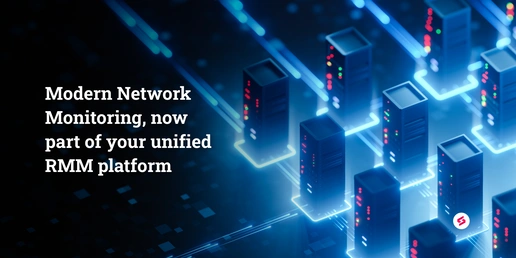The roles of a vCIO, the advantages and disadvantages of employing a vCIO, and what it means for MSPs.
Not every business can afford its own CIO (Chief Information Officer). The majority of small and medium-sized businesses employ an outside contractor of an MSP (Managed Services Provider) to fulfill the role. MSPs undergo rigorous training to manage the people, processes, and technologies of an IT infrastructure to align the outcomes of a business with their goals.
However, MSPs aren't always equipped with the resources to deal with the day-to-day challenges a CIO faces. With a comprehensive understanding of how CIOs achieve transformative outcomes and what they need to do so, MSPs can upgrade their services as vCIOs to deliver technical environments that effectively accomplish results.
In this article, we'll highlight the roles of a vCIO, the advantages and disadvantages of employing a vCIO, and what it means for MSPs.
What is a Virtual CIO?
A vCIO (or virtual chief information officer) is someone who oversees the technology strategy of an organization's IT infrastructure on a contractual basis. They routinely collaborate with business leaders and IT departments to provide consultation on the client’s IT infrastructure strategy.
Their primary responsibilities include devising effective IT strategies, setting goals, overseeing IT budgeting, and identifying and improving business operations by leveraging new-age technologies and processes.
In addition to this, they also help businesses achieve their long-term goals and increase revenue by driving innovation through disruption.
A vCIO is especially effective at producing fruitful results in organizations that are understaffed and would benefit from the strong decision-making and authoritative direction of a CIO.
A virtual CIO typically has the same duties as a traditional CIO; they manage and secure a company's existing IT infrastructure and help them evolve with changing times. However, the focus of a vCIO which is undertaken by a third-party IT advisory, like an MSP, is to onboard business and technological alignment rather than just technological services which an in-house CIO delivers.
What does it mean for an MSP?
Businesses, especially small to medium-sized, can not always afford to have their own CIOs. However, as SMBs are acknowledging the importance of digital transformation to thrive in a competitive marketplace, hiring a third-party vCIO has become a necessary step for companies to manage and secure their entire IT infrastructure.
Here, the services of an MSP can help SMBs maintain smooth IT operations without necessarily being set back by budgetary challenges. It allows them to efficiently and flexibly manage large-scale IT projects or pursue digital transformation without a resource-intensive staff and at a reasonable price point.
Virtual CIOs, like in-house CIOs, have a comprehensive grasp of ever-evolving corporate environments and carry the necessary technical expertise and interpersonal skills needed to align long-term IT strategies with business goals.
Regardless of what a business’s offerings are, technology plays a critical role in producing the desired results. This includes securing your IT operations, processing payments, communicating with clients and customers, setting up appointments, collaborating remotely, and so on.
With technology being the driving force of your business, it is safe to say you can benefit from the strategic expertise of a vCIO.
Whether you need to contract a vCIO on a need-to-need basis or an ongoing basis, a vCIO ensures that a business is equipped to tackle disruptive challenges and competition.
CIO vs. vCIO: What's the difference?
There is a range of differences between a conventional CIO and a virtual CIO, and how each operates:
- CIOs are employed by companies as in-house staff and are paid accordingly. VCIOs, on the other hand, work on contractual agreements and may provide consultation to more than one client at a time.
- The responsibilities of an in-house and virtual CIO are typically the same, however, their levels of expertise, approach towards consultations, and efficacy in their tasks may vary. For instance, since CIOs are a strategic part of an organization, they are likely to have a firm grasp of the organization's goals, decision-making authority, and leadership dynamics. However, they are likely to be influenced by internal politics that inhibit an objective perspective toward strategy-building. Virtual CIOs can be highly effective here with their diversified experience and unique perspective.
- Hiring an in-house CIO follows the same recruitment practices involving human resources. A vCIO, on the other hand, is onboarded via a third-party IT vendor like an MSP, where companies can ditch the time-consuming and resource-intensive hiring process.
- An in-house CIO is paid a fixed salary and enjoys employee benefits as any other salaried person would. The prices of a vCIO are determined based on negotiations between the vendor and the client. Since vCIOs provide on-demand consultation, they charge a flat fee and are typically well-paid. However, organizations save a ton of money on additional employee benefits. It's up to the kind of compensation model the vendor and the client subscribe to - while some opt for monthly payments, other MSPs work around different frequencies.
A vCIO usually works on an hourly-rate providing technical advice in key decision-making processes. Since they cater to multiple clients at a time, the overall cost of a vCIO is less than what is typically paid to a full-time CIO who also enjoys employee benefits.
Key qualities enterprises look for in a vCIO
Knowing what a business’s expectations are from a vCIO helps MSPs refine their offerings for the best results. Let's look into the primary capabilities enterprises look for in vCIOs:
- Technical expertise to align IT strategy to business goals: Enterprises require CIOs to carry the necessary domain expertise that helps them achieve business objectives. To do so, they should be effective at strategy-building and communicating with the organization's key executives.
- Expert interpersonal skills: For vCIOs to be effective in their roles, they must have strong interpersonal skills to work with IT leaders and the organization's IT staff. To do so, it's important to be clear about their availability and capability. They should be able to cater to an organization according to their work culture and ethics.
- Understanding of IT project management: vCIOs should know how to proactively respond to challenges in IT projects while sticking to predetermined budgets.
- Knowledge of IT budgeting: A vCIO should have a firm grasp of the IT budgeting process to be able to plan and optimize costs and track ROIs for existing strategies and technologies.
- Know-how of tech trends: Virtual CIOs should stay updated with the latest technologies and be able to leverage them, if need be, to serve a business effectively. The best CIOs regularly sit down with key decision-makers and customers to determine how business needs are evolving so that they can devise strategies that address changing demands.
- Proactive planning to address changing business goals: vCIOs are brought on board to help businesses evolve with changing trends. This requires them to be proactive planners who are aware of market trends and can gravitate a company towards success despite disruptive challenges.
How can MSPs include vCIO in their offerings?
Adding vCIO services to your repertoire requires a strategic approach. This usually depends on your clients. Categorize them based on priority. For instance, you can have three buckets: A, B, and C, where the former two demand the highest priority and the latter can be attended to at the end.
Before you onboard a client, make sure you have a strategic vCIO process to excel in the role. This will ensure you are well-equipped to handle challenges and best align their needs with business goals.
Here's breaking down the process for you:
- To begin with, identify a qualified individual within your business who will fulfill the role of a vCIO. Make sure it is someone who can effectively manage people, processes, and technologies within set goals.
- Next, strategically plan what goals and targets your vCIO needs to hit every quarter. At the end of every quarter, set new goals.
- MSPs can employ technological solutions and vCIO tools to help their vCIOs accomplish goals. For instance, a ticketing system to assist your helpdesk resources. If you are not leveraging tools, you will likely be less efficient than your competition.
Advantages of a vCIO
One of the primary benefits of undertaking the services of a vCIO is that it helps SMBs that lack the budget and resources to thrive in a competitive atmosphere. In addition to this, there is a myriad of advantages of using a vCIO:
- Unlike hiring an in-house CIO, onboarding a vCIO is simpler and significantly less consuming. This saves your human resources departments both effort and money.
- Third-party advisory services like an MSP often provide more than one vCIOs to clients to cater to their on-demand needs. Thus, you can expect the availability of a vCIO 24×7.
- Businesses often need a fresh perspective to address competitive challenges. Here, the objectivity of a vCIO who is devoid of any internal political influence can be extremely effective.
- Virtual CIOs are best suited for SMBs who lack the breadth of technological expertise, resources, or budget to steer organizations in the right direction. It helps SMBs leverage the high-level domain experience of vCIOs at highly manageable price points, which is a massive advantage.




